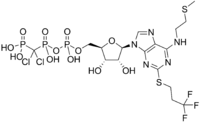Cangrelor
| Cangrelor | |
|---|---|
 | |
| IUPAC name [dichloro-[[[(2R,3S,4R,5R)-3,4-dihydroxy-5-[6-(2-methylsulfanylethylamino)-2-(3,3,3-trifluoropropylsulfanyl)purin-9-yl]oxolan-2-yl]methoxy-hydroxyphosphoryl]oxy-hydroxyphosphoryl]methyl]phosphonic acid | |
| Identifiers | |
| CAS number | 163706-06-7 |
| PubChem | 9854012 |
| ChemSpider | 8029718 |
| IUPHAR ligand | 1776 |
| Jmol-3D images | {{#if:CSCCNC1=NC(=NC2=C1N=CN2[C@H]3[C@@H]([C@@H]([C@H](O3)COP(=O)(O)OP(=O)(C(P(=O)(O)O)(Cl)Cl)O)O)O)SCCC(F)(F)F|Image 1 |
| |
| |
| Properties | |
| Molecular formula | C17H25Cl2F3N5O12P3S2 |
| Molar mass | 776.36 g mol−1 |
| Except where noted otherwise, data are given for materials in their standard state (at 25 °C (77 °F), 100 kPa) | |
| Infobox references | |
Cangrelor is a P2Y12 inhibitor under investigation as an antiplatelet drug[1] for intravenous application. Some P2Y12 inhibitors are used clinically as effective inhibitors of adenosine diphosphate-mediated platelet activation and aggregation.[1] Unlike clopidogrel (Plavix), which is a prodrug, cangrelor is an active drug not requiring metabolic conversion.
Poor interim results led to the abandonment of the two CHAMPION clinical trials in mid-2009.[2] The BRIDGE study, for short term use prior to surgery, continues.[3] The CHAMPION PHOENIX trial was a randomized study of over 11,000 patients published in 2013. It found usefulness of cangrelor in patients getting cardiac stents. Compared with clopidogrel given around the time of stenting, intravenous ADP-receptor blockade with cangrelor significantly reduced the rate of stent thrombosis and myocardial infarction.[4] Reviewers have questioned the methodology of the trial.[5]
References
- ↑ 1.0 1.1 Cangrelor Attenuates Coated-Platelet Formation
- ↑ CHAMPION Trials With Cangrelor Stopped for Lack of Efficacy
- ↑ What Cangrelor Failure Means to Medicines
- ↑ Effect of Platelet Inhibition with Cangrelor during PCI on Ischemic Events (2013) Bhatt, DL etal. New England Journal of Medicine March 10, 2013 doi:10.1056/NEJMoa1300815 (published initially online).
- ↑ The Duel between Dual Antiplatelet Therapies (2013) Lange, RA and Hillis, LD. New England Journal of Medicine March 10, 2013 doi:10.1056/NEJMe1302504
| |||||||||||||||||||||||||||||||||||||||||||||||||||||||